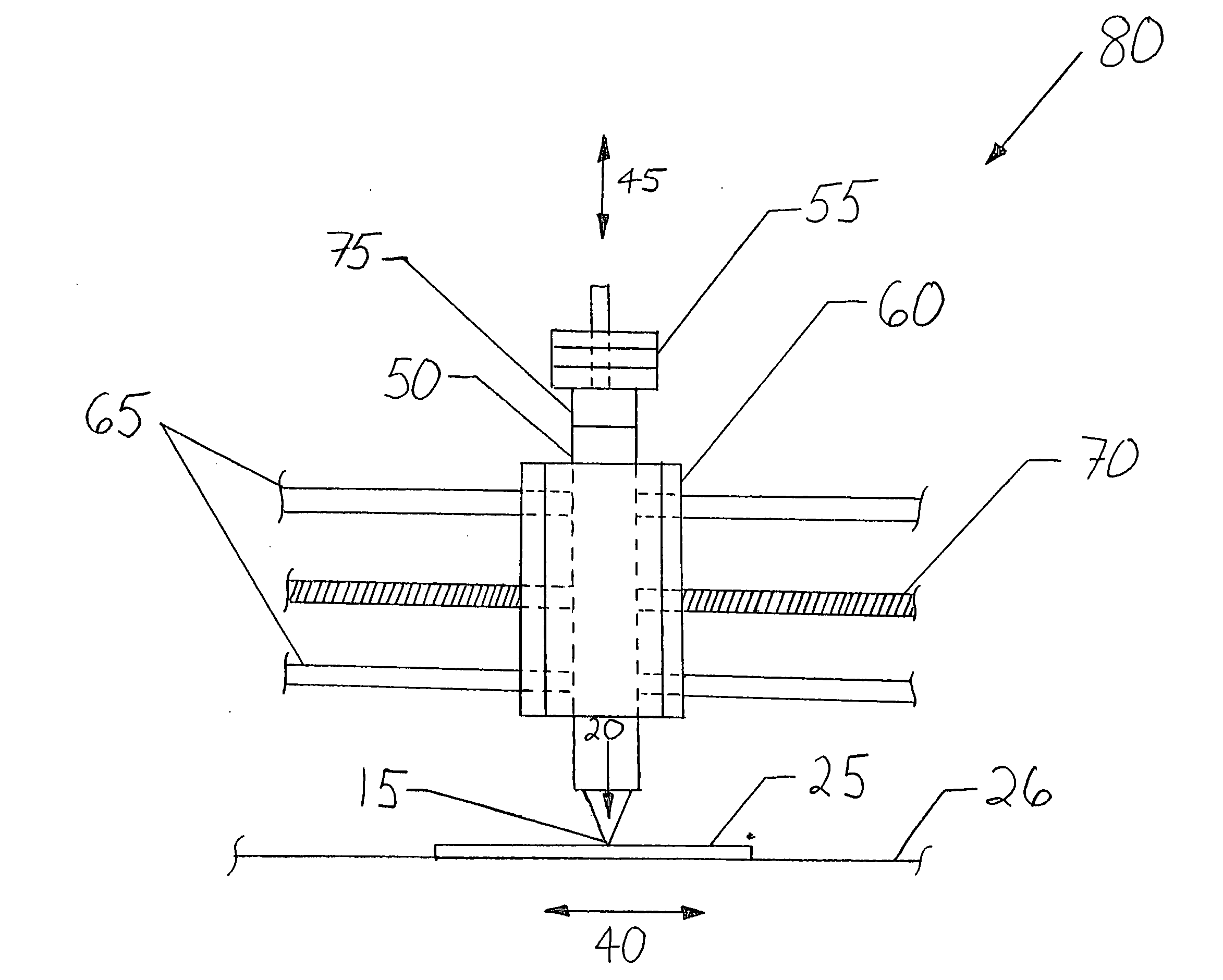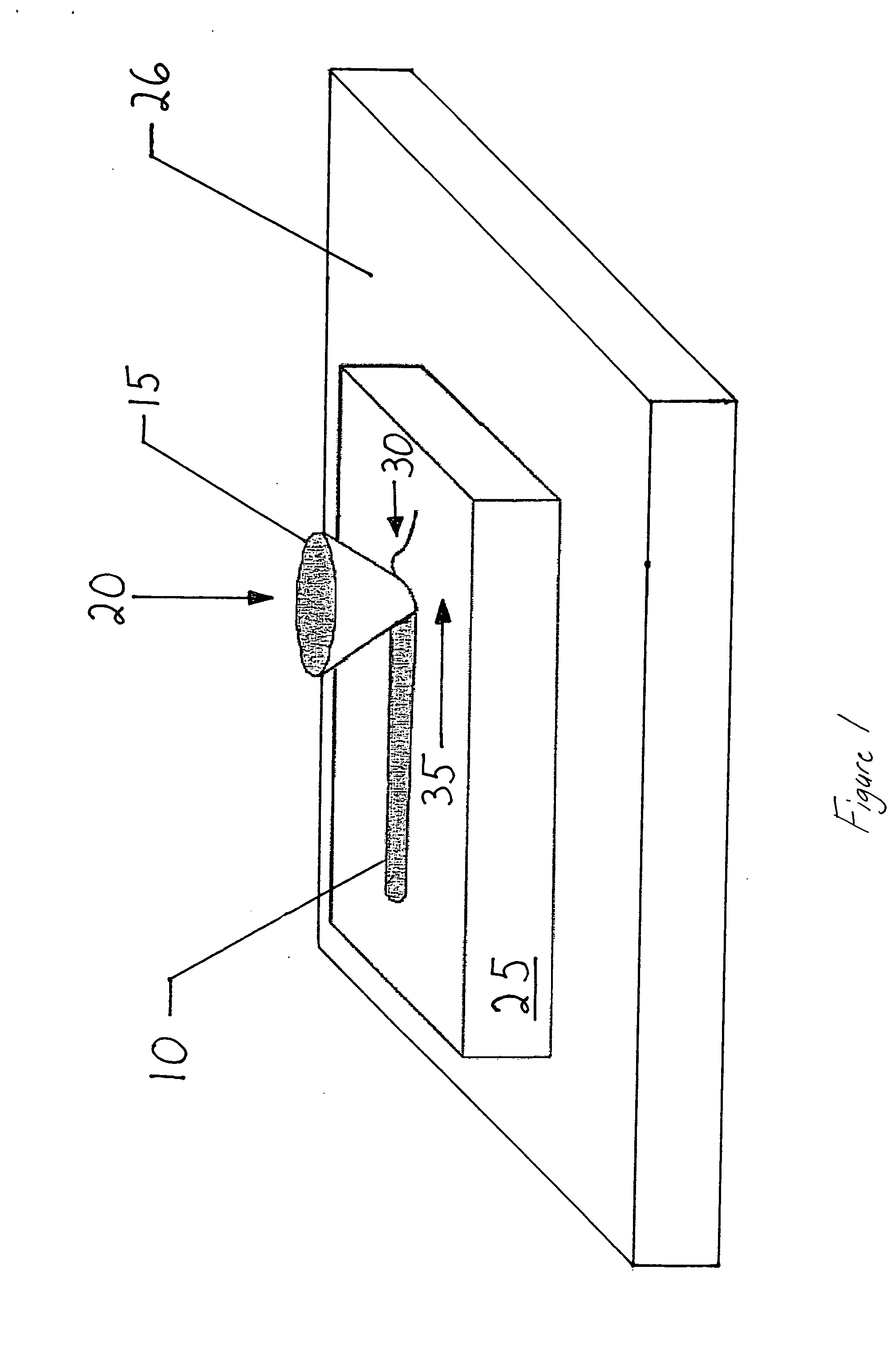Scratch testing device
a technology of scratch testing and testing means, which is applied in the direction of measurement devices, instruments, scientific instruments, etc., can solve the problems of limited means and methods recognized for surface testing and analysis, inconvenient use, and inability to meet the requirements of the test,
- Summary
- Abstract
- Description
- Claims
- Application Information
AI Technical Summary
Problems solved by technology
Method used
Image
Examples
example 1
[0070] To assess the frictional force and determine the scratching coefficient of friction of a polypropylene with talc filler specimen, controlled scratch tests were administered with a scratch testing device having a variable load generating device, a scratch depth sensor, a linear load sensor, and a load sensor. Real time data such as scratch distance, load, and friction force, respectively were captured during the scratch process.
[0071] The scratching coefficient of friction, which represents the resistance of a material to scratching, was calculated from the ratio of the friction force to the normal load. The frictional force and scratching coefficient of friction were then graphically plotted as a function of scratch distance as shown in FIG. 6. For this particular test, a scratch was applied on a polypropylene specimen under an increasing load from 2.0 to 50.0 N±0.1 N over a distance of 0.1 m±10.0005 m at a constant rate of 0.1 m / s±10.0005 m / s. Dashed line (1001) represents ...
example 2
[0073] To assess the load at which whitening occurred (i.e., the critical load) for different polypropylene systems, controlled scratch tests were administered with the scratch testing device of Example 1. For this example, a scratch was applied to different material specimens under an increasing load from 2.0 to 50.0 N±0.1 N over a distance of 0.1 m±0.0005 m at a constant rate of 0.1 μm / s±0.0005 m / s. To determine the critical point for the onset of whitening, image capturing equipment, VIEEW, was utilized with a consistent set of light and grey-scale settings. The VIEEW digital image analyzer is manufactured by Atlas (http: / / www.atlas-mts.com). FIG. 7 illustrates the critical normal load at which the onset of whitening begins for various polymer systems.
[0074] As shown in FIG. 7, for the homopolymer polypropylene specimen (no filler), no whitening was apparent on the sample after the test. For the polypropylene with talc filler specimen, whitening occurred at a critical normal loa...
example 3
[0075] To assess the repeatability and reproducibility of the scratch testing device of Example 1, controlled scratch test were administered. A scratch was applied on a polypropylene specimen under an increasing load from 2.0 to 50.0 N±0.1 N over a distance of 0.1 m±0.0005 m at a constant rate of 0.1 μm / s±0.0005 m / s.
[0076] Two test runs with the scratch testing device were conducted. Each test run was based on the average of three tested samples. The test runs were conducted by the same operator under the same operating conditions using the same scratch testing device on the same day. Table 1 below shows the results of this test. For Test Run 1, the average load at which whitening occurred was 6.79 N, with a standard deviation of ±0.26 N. For Test Run 2, the average load at which whitening occurred was 6.61 N, with a standard deviation of ±0.38N.
TABLE 1Repeatability Data—Critical Normal Load for Whitening(Single Operator)Test RunAverageSrA16.79=0.2626.61=0.38
[0077] In addition, a...
PUM
| Property | Measurement | Unit |
|---|---|---|
| linear speed | aaaaa | aaaaa |
| linear speed | aaaaa | aaaaa |
| acceleration | aaaaa | aaaaa |
Abstract
Description
Claims
Application Information
 Login to View More
Login to View More - R&D
- Intellectual Property
- Life Sciences
- Materials
- Tech Scout
- Unparalleled Data Quality
- Higher Quality Content
- 60% Fewer Hallucinations
Browse by: Latest US Patents, China's latest patents, Technical Efficacy Thesaurus, Application Domain, Technology Topic, Popular Technical Reports.
© 2025 PatSnap. All rights reserved.Legal|Privacy policy|Modern Slavery Act Transparency Statement|Sitemap|About US| Contact US: help@patsnap.com



